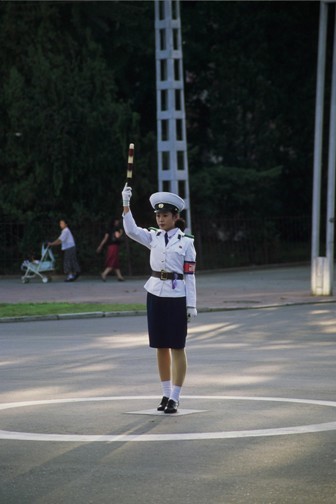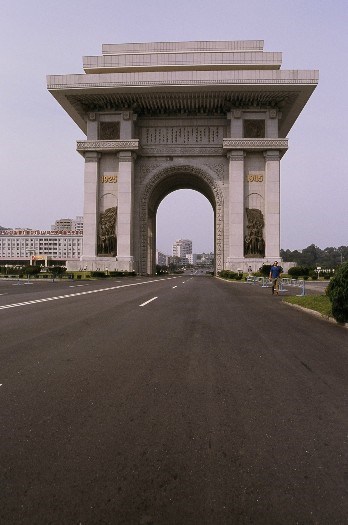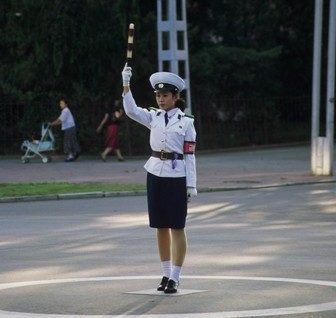Editor: From the Travelodium Archive this article was first published in 2009.
It’s Sunday in Pyongyang – the day of 10,000 steps, when each citizen shuns wheels and takes to the streets on foot. The official line is that this is an eco-friendly initiative designed to help save petrol. The pessimistic (or perhaps realistic) view is that there simply isn’t enough fuel to go around – not even for the few who actually own a car.

Truthfully, there’s little to distinguish Sunday from any other day. I’ve never seen a city as quiet as North Korea’s capital. It’s so quiet that the rickety Soviet-inspired buses and occasional cars provide a curiosity worthy of our photographs and since traffic accidents don’t seem to be an issue, we opt for the top vantage point – the middle of the road. When two cars do actually cross paths, the occasion is marked by one of the city’s most elegant and photogenic sights.
Pyongyang Traffic Police
Clearly hired for their exquisite features and decked out in porcelain doll make up, Pyongyang’s all-female traffic police lend a little theatre to a city with a non-existent arts scene. Their perfectly orchestrated gestures are like some kind of high street ballet, inevitably drawing the largest crowd a city with so few tourists can muster. Never faltering, they spin on the spot, keeping perfect time with rapid jerks of the head and flowing hand signals and as I stand mesmerised by their movements I wonder whether they might cause more accidents than they avert.
The atmosphere in Pyongyang somehow reminds me of Christmas Day. Not the cheerful loving and giving spirit that envelopes people at Christmas; I mean the eerie feeling you’ll have noticed if you’ve ever ventured far from your house once the present opening rituals are over. Silence reins over deserted streets devoid of both cars and pedestrians; everything looks right – clocks still tick, the traffic lights still change – but it’s like a stage set without players. That’s how Pyongyang feels and you constantly wonder if there might be a party happening somewhere that you didn’t receive an invite for.

Pjongyang Architecture
Often referred to as ‘the showcase capital’, you do suspect that many of the grandiose Lego brick buildings are little more than sombre grey facades harbouring the secret of an empty interior. Few would consider this a pretty city, but despite its unmistakably communist architecture, Pyongyang is certainly striking. Immense monuments marking the superiority of Juche (self-reliance) draw your eye from the crumbling apartment blocks they are set amongst. The most impressive is the 20m-high bronze statue of the Great Leader, Kim Il Sung (the world’s only deceased head of state). The faithful arrive (on foot naturally) daily to lay flowers at the feet of their god, bow before his image then admire the elaborate monuments either side of the statue – vast carvings showing loyal subjects glorious after defeating their capitalist enemies.
If you spend too long admiring the intricate workmanship of Pyongyang’s countless monuments, murals and paintings you might be forgiven for believing this to be a land of plenty. But never far away is Pyongyang’s tallest building, a reminder that all is not golden in the Hermit Kingdom. Visible from everywhere but your hotel bathroom, this colossal pyramid is the ultimate ‘elephant in the room’.
It sneaks into the background of almost every photograph, but is never mentioned in the daily spiel dished out by compulsory government guides. Started in 1987, the Ryugyong Hotel is a 105-storey architectural nightmare topped with space for seven revolving restaurants (the ultimate measure of refinement in a North Korean hotel). Sadly, the cash to finish this sore-thumb project petered out and the empty, windowless shell has loomed over Pyongyang, threatening to collapse for over a decade.
Offering much the same appeal as a haunted house to an inquisitive child, we long to get closer to its thousand gaping windows, but it was not to be. Aside from the potential danger of nearing the allegedly crumbling edifice, North Korea is not a place to showcase its embarrassments and the government hasn’t yet managed to put a positive spin on this almighty gaffe.
By night, Pyongyang remains fascinating if a touch more depressing. Strictly speaking, tourists are confined to the elaborate lobbies and extensive entertainment facilities of their hotels after dark. Naturally some escape, but they don’t get far – and not because they’re captured and returned to base camp. Either Pyongyang is truly the greenest capital on earth or else there’s a dire lack of electricity. When the sun sets, the city is plunged into darkness, save for a smattering of apartment lights, the immense glow let off by the Juche Tower’s fake flame and any floodlights pointing towards an image of the Great Leader.
For the uninitiated visitor the absolute lack of light coupled with rutted, unkempt pavements makes for a nerve-wracking evening stroll. After resorting to walking on the comparatively smooth road, most head back after their first brush with a motorist, presumably also saving on power by driving without headlights. If you can just drag your eyes from the darkness enveloping your feet, you notice that the lack of light does offer one glorious benefit. Looking up I realised these were the first Asian stars I’d seen in a six-month trip. For all its faults – questionable politics and an abundance of grey edifices among them – Pyongyang does have its virtues. The skies are clearer than anywhere in the Far East, the air is a pleasure to breath and the streets are devoid of litter. All in all, it’s a delightful place to explore on foot, which is probably just as well.

